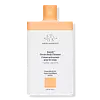What's inside
What's inside
 Key Ingredients
Key Ingredients

No key ingredients
 Benefits
Benefits

 Concerns
Concerns

No concerns
 Ingredients Side-by-side
Ingredients Side-by-side

Water
Skin ConditioningSodium Laurylglucosides Hydroxypropylsulfonate
CleansingCocamidopropyl Hydroxysultaine
CleansingCoco-Glucoside
CleansingSodium Methyl Cocoyl Taurate
CleansingGlycerin
HumectantGlyceryl Caprylate
EmollientCaprylhydroxamic Acid
Sodium Lauroyl Oat Amino Acids
CleansingHelianthus Annuus Seed Oil
EmollientAloe Barbadensis Leaf Juice
Skin ConditioningSimmondsia Chinensis Seed Oil
EmollientCamellia Sinensis Extract
AntioxidantCalendula Officinalis Flower Extract
MaskingAvena Sativa Straw Extract
Skin ConditioningCitric Acid
BufferingWater, Sodium Laurylglucosides Hydroxypropylsulfonate, Cocamidopropyl Hydroxysultaine, Coco-Glucoside, Sodium Methyl Cocoyl Taurate, Glycerin, Glyceryl Caprylate, Caprylhydroxamic Acid, Sodium Lauroyl Oat Amino Acids, Helianthus Annuus Seed Oil, Aloe Barbadensis Leaf Juice, Simmondsia Chinensis Seed Oil, Camellia Sinensis Extract, Calendula Officinalis Flower Extract, Avena Sativa Straw Extract, Citric Acid
Water
Skin ConditioningSodium Laurylglucosides Hydroxypropylsulfonate
CleansingCoco-Glucoside
CleansingGlycerin
HumectantCocamidopropyl Betaine
CleansingSodium Methyl Cocoyl Taurate
CleansingSodium Chloride
MaskingSclerocarya Birrea Seed Oil
HumectantCoconut Alkanes
EmollientPassiflora Edulis Seed Oil
EmollientPlukenetia Volubilis Seed Oil
EmollientPrunus Amygdalus Dulcis Oil
Skin ConditioningCaprylic/Capric Triglyceride
MaskingCassia Hydroxypropyltrimonium Chloride
Carbomer
Emulsion StabilisingSodium PCA
HumectantPanthenol
Skin ConditioningGlycol Distearate
EmollientSodium Lactate
BufferingHelianthus Annuus Seed Oil
EmollientGlycine Soja Oil
EmollientPCA
HumectantAlanine
MaskingArginine
MaskingGlycine
BufferingHistidine
HumectantIsoleucine
Skin ConditioningPhenylalanine
MaskingProline
Skin ConditioningSerine
MaskingThreonine
Valine
MaskingCoco-Caprylate/Caprate
EmollientAspartic Acid
MaskingPrunus Amygdalus Dulcis Seed Extract
Skin ConditioningBenzoic Acid
MaskingPhenoxyethanol
PreservativeDehydroacetic Acid
PreservativeSodium Acetate
BufferingWater, Sodium Laurylglucosides Hydroxypropylsulfonate, Coco-Glucoside, Glycerin, Cocamidopropyl Betaine, Sodium Methyl Cocoyl Taurate, Sodium Chloride, Sclerocarya Birrea Seed Oil, Coconut Alkanes, Passiflora Edulis Seed Oil, Plukenetia Volubilis Seed Oil, Prunus Amygdalus Dulcis Oil, Caprylic/Capric Triglyceride, Cassia Hydroxypropyltrimonium Chloride, Carbomer, Sodium PCA, Panthenol, Glycol Distearate, Sodium Lactate, Helianthus Annuus Seed Oil, Glycine Soja Oil, PCA, Alanine, Arginine, Glycine, Histidine, Isoleucine, Phenylalanine, Proline, Serine, Threonine, Valine, Coco-Caprylate/Caprate, Aspartic Acid, Prunus Amygdalus Dulcis Seed Extract, Benzoic Acid, Phenoxyethanol, Dehydroacetic Acid, Sodium Acetate
 Reviews
Reviews

Ingredients Explained
These ingredients are found in both products.
Ingredients higher up in an ingredient list are typically present in a larger amount.
Coco-Glucoside is a surfactant, or a cleansing ingredient. It is made from glucose and coconut oil.
Surfactants help gather dirt, oil, and other pollutants from your skin to be rinsed away.
This ingredient is considered gentle and non-comedogenic. However, it may still be irritating for some.
Learn more about Coco-GlucosideGlycerin is already naturally found in your skin. It helps moisturize and protect your skin.
A study from 2016 found glycerin to be more effective as a humectant than AHAs and hyaluronic acid.
As a humectant, it helps the skin stay hydrated by pulling moisture to your skin. The low molecular weight of glycerin allows it to pull moisture into the deeper layers of your skin.
Hydrated skin improves your skin barrier; Your skin barrier helps protect against irritants and bacteria.
Glycerin has also been found to have antimicrobial and antiviral properties. Due to these properties, glycerin is often used in wound and burn treatments.
In cosmetics, glycerin is usually derived from plants such as soybean or palm. However, it can also be sourced from animals, such as tallow or animal fat.
This ingredient is organic, colorless, odorless, and non-toxic.
Glycerin is the name for this ingredient in American English. British English uses Glycerol/Glycerine.
Learn more about GlycerinHelianthus Annuus Seed Oil is the oil derived from the seeds of a Sunflower. Sunflower seed oil is non-fragrant. It is an emollient, meaning it helps to soften the skin.
Sunflower seed oil contains many fatty acids. The fatty acids found in sunflower seeds include (from highest amount to least): linoleic acid, myristic acid, palmitic acid, stearic acid, arachidic acid, oleic acid, and linolenic acid.
These fatty acids help the skin create ceramides. Ceramides play a role in repairing the skin barrier.
Helianthus Annuus Seed Oil helps moisturize the skin. This in turn helps the skin look more rejuvenated and smoother.
Sunflowers are rich in vitamin E.
Historians believe Indigenous cultures of North America domesticated sunflowers before corn. Thus they relied on sunflower oil for a variety of uses. One such use is moisturizing skin and hair.
Sunflower seed oil may not be fungal acne safe. We recommend speaking with a professional if you have any concerns.
Learn more about Helianthus Annuus Seed OilWe don't have a description for Sodium Laurylglucosides Hydroxypropylsulfonate yet.
This gentle cleansing and foaming ingredient is known for leaving a smooth feeling in skin and hair. It is made using coconut oil.
According to the manufacturer, it is soluble in water and has resistance to hard water, acid, and alkali.
Due to its coconut base, it may not be Malassezia folliculitis safe.
Learn more about Sodium Methyl Cocoyl TaurateWater. It's the most common cosmetic ingredient of all. You'll usually see it at the top of ingredient lists, meaning that it makes up the largest part of the product.
So why is it so popular? Water most often acts as a solvent - this means that it helps dissolve other ingredients into the formulation.
You'll also recognize water as that liquid we all need to stay alive. If you see this, drink a glass of water. Stay hydrated!
Learn more about Water